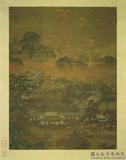明陳洪綬畫隱居十六觀 冊 品梵
推薦分享
資源連結
連結到原始資料 (您即將開啟新視窗離開本站)後設資料
- 資料識別:
- 故畫001162N000000016
- 資料類型:
- 類型:繪畫
- 型式:靜態圖像
- 著作者:
- 陳洪綬
- 主題與關鍵字:
- 僧(和尚、尼姑) 宗教器用 傢俱(屏風)
- 出版者:
- 數位化執行單位:國立故宮博物院
- 格式:
- 本幅 21.4x29.8公分、全幅 71公分
- 關聯:
- 石渠寶笈初編(養心殿),上冊,頁492-493&*故宮書畫錄(卷六),第四冊,頁87-88&*故宮書畫圖錄,第二十三冊,頁238-243&* 陳洪綬(西元一五九八至一六五二年),字章侯,早年自號蓮沙彌,後號老蓮。明亡後,自稱悔遲,又稱勿遲。浙江諸暨人。人物、花鳥、草蟲、山水無不精明,皆能自出機杼,高古奇駭,為晚明極具影響力之大畫家。 畫中二羅漢並坐几前閱經,一俯首專注經文,一雙手托經,張口欲言,似擬討論經句。羅漢造型奇古,衣紋勻圓遒勁,墨線之上復勒以青、赭,於白描之清雅中加以變化。本幅選自「隱居十六觀」第十開,為老蓮五十四歲所繪,乃逝世前一年之作品。 &*Lohans Studying Sûtras Ch’en Hung-shou (1598-1652) Ming Dynasty Ch’en Hung-shou was a native of Chu-chi, Chekiang, and his style name was Chang-hou. In his youth, he called himself Lien-sha-mi (The Lotus Novice) and later called himself Lao-lien (The Old Lotus). After the fall of the Ming dynasty in 1644, he called himself Hui-ch’ih (Too Late to Regret) and Wu-ch’ih (Not Too Late). His depictions of human figures, birds, flowers, insects, and landscapes are all pure, archaic, and eccentricly marvelous. Ch’en Hung-shou was an extremely influential late Ming dynasty master. In this painting are two lohans seated before a table studying sûtras. One bows his head concentrating on a sûtra. The other holds one in his hands, opening his mouth as if wanting to utter or discuss something from a section of the sûtra. The designs of the lohans appear bizarre and archaic, and the drapery lines are even and uniform, round and forceful. Repeated above the black ink lines are blue and red lines, which provide an elegant and fresh variation on the pai-miao (plain-line) manner. This painting is the tenth leaf from the album “Sixteen Views of Dwelling in Seclusion” and was painted by Ch’en Hung-shou when he was 53-years-old, one year before he died. &*1.李玉珉,〈明陳洪綬品梵〉,收入李玉珉主編,《羅漢畫》(臺北:國立故宮博物院,1990年初版),頁81。
- 管理權:
- 國立故宮博物院
授權聯絡窗口
- 國立故宮博物院圖像授權、出版授權、影音資料授權-申請流程說明
http://www.npm.gov.tw/zh-TW/Article.aspx?sNo=03003061






